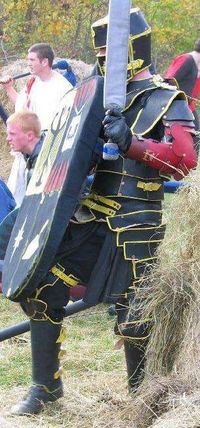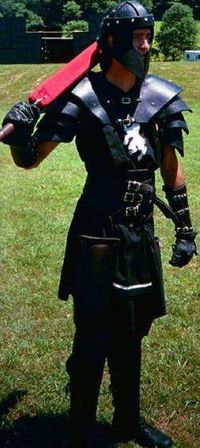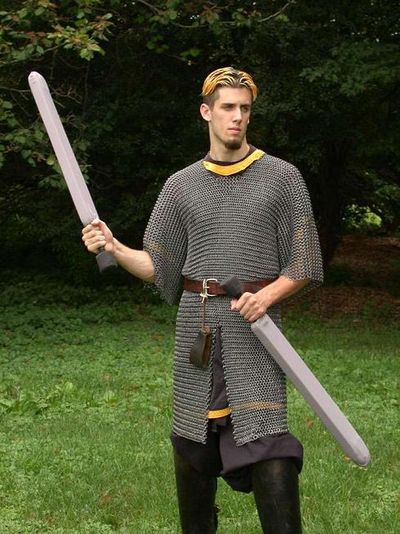Armour (NRSKW)

The primary use of armour in Belegarth MCS is to give the wearer in game protection against many weapons. Many people choose to wear armour due to this; however it is not required to safely participate. The full rules for the use of armour can be found in the Book of War, however I will go over the basics here.
Armour Basics
Armour grants protection only where it is physically located on the body. For example, if a fighter has a bracer on their lower forearm and is struck in the bicep by a weapon, the armour does not grant any protection and the limb is lost. It is not possible to wear one kind of armour over another kind to gain additional hits. Fighters may do this if they wish, but they gain no advantage from it. In order to count as armour, the armour piece must cover at least one third of the target area. This means that if you had a very small bracer (less than 1/3 the length of your arm), it would not count as armour. The exception to this is if you have a continuous piece of armour from one area to another. For example, if you were wearing a chain maille shirt with short sleeves, the sleeves would still act to protect the area of the arm they cover. Extending this example, if a person wearing a chain maille shirt and bracers were struck in the chest, the chest armour would no longer confer an extra hit, but the sleeves still would. If the person were then struck in one sleeve, neither the sleeve nor the bracer on that arm would continue to function as armour. The other sleeve and bracer still would, however.

Armour grants one additional hit from class I (blue) weapons. If a fighter is struck in an armored location by a blue weapon for the first time, they should yell, “armour!” and continue to fight. If they are struck in the torso (either front or back) again, they will die. Armour grants additional hits in the torso, both the arms, both the legs, and completely protects the head from class IV and V weapons. This means that a fully armored fighter could be struck once in the torso, once in each arm, and once in each leg without losing a limb or dying. If they were to be struck in any of those locations again by a class I or II weapon, they would react as if they had no armour. Class II or red weapons ignore armour completely when used with two hands. Armour completely protects the wearer from one handed class III (green) thrusts, but two handed class III thrusts ignore armour completely. Class IV (yellow) weapons always ignore armour and a helmet completely protects against class IV and class V (white) weapons.

Pros and Cons of Armour
There are many advantages and disadvantages to having armour and new fighters should consider them both before deciding to get armour. The primary advantage of armour is that it confers extra hits to the wearer. Many new fighters ask whether different types of armour confer different bonuses. Under the current rules system, all armour types grant the same protection to the wearer. Some people question why heavier armour like chain or plate does not give two or three extra hits instead of just one. The primary reason for this is to keep the game as simple as possible. It would be difficult for a fighter to keep track of one hit on his left arm, two on his body, one on his right leg, and three on his left leg while in the middle of a pitched melee.
Another advantage that should be taken into consideration is that armour can act as very nice garb and can say a lot about the character you are portraying. When considering garb and armour, the wearer should be aware that they are not allowed to cover their armour to the point where other fighters cannot tell they are wearing armour. Armour must always be in plain sight.
There are obvious advantages to wearing armour but there are also some not-so-obvious disadvantages. The primary disadvantage to wearing armour is encumbrance. Depending on the kind of armour, it can be very heavy, hot, and restrictive. Many fighters that wear armour choose not to wear it on very hot days because of the danger of exhaustion and dehydration. Aside from armour’s encumbering nature, it is also expensive. Some armour is less expensive than others and it is less expensive to make your own than to buy it, but no matter how you get armour, it will be a significant investment.

Another disadvantage to wearing armour is that the wearer becomes more dangerous to themselves and others on the field. The wearer needs to always consider that they are wearing armour before bashing or grappling an opponent. When grappling, there are specific rules governing armour wearers. Armour is divided into three categories, leather, chain, and plate. Leather wearers cannot initiate a grapple with non-armored opponents. Chain wearers cannot initiate a grapple with non-armored or leather armored opponents. Plate wearers cannot initiate a grapple with non-armored, leather wearing, or chain wearing opponents. If a non-armored opponent initiates a grapple with an armored opponent the armour wearing fighter is, however, allowed to return the grapple.
A lesser-recognized disadvantage to armour is that it tends to promote lazy fighting. Fighters in armour are more apt to allow their opponent to strike them, knowing that they will not lose a limb or die. Sometimes this can be a valid tactic to bait the enemy into exposing a weakness, but most of the time it just prevents the armour wearing fighter from growing into a better fighter. This is especially true for new fighters.
Obtaining Armour
There are two primary ways to go about getting armour. You can either buy it or make it. The easier of the two is to just buy it completed. This is of course more expensive, but it requires less input of time and energy researching how to best go about making armour. There are many reputable armourers in the Belegarth community that make and sell very high quality and inexpensive armour legal for Belegarth fighting. If you cannot find armour you like within the Belegarth community, there are also many high quality dealers to be found on the internet.
For the fighters with more time than money, it is possible to make very quality armour without a large investment of money. The cheapest armour to make is chainmaille, however it does require the largest input of time. If you would like to balance cost and effort, leather armour may be a better route. Sometimes finding leather and leather working supplies near you can be a problem, but everything you need can be found on the internet if you cannot locate it locally. Plate armour is the most difficult to make yourself and most people that undertake plate armour do so because they are interested as much in the process of making the armour as they are in having the finished product.

